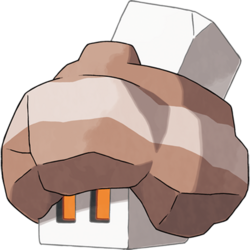From Bulbapedia, the community-driven Pokémon encyclopedia.

|
The subject of this article is a Pokémon which has recently been announced.
This article's contents will change as more information becomes available, perhaps abruptly. Please be cautious when adding information to this article, as rumors and speculation can often be confused with facts. Avoid any information on this subject which is not confirmed by reliable sources.
|
Nacli (Japanese: コジオ Kojio) is a Rock-type Pokémon introduced in Generation IX.
It evolves into Naclstack starting at level 24, which evolves into Garganacl starting at level 38.
Biology
Nacli is a Pokémon composed of rock salt. Its upper body is rugged and brown, with an off-white stripe circling it, while its lower body is a white salt cube with rectangular orange-yellow eyes. A white salt cube is embedded on the top half of its body as well.
Nacli are born deep within the earth, inside layers of rock salt. Bits of salt are scraped off of Nacli as it travels the ground, although Nacli is able to create and replenish salt inside its body as well. In the past, Nacli was treasured by people who would use its salt. Even today, Nacli salt is still used in foods such as ice cream, because it has a gentle flavor.
Nacli and its evolutions are the only known Pokémon with the Ability of Purifying Salt.
In the anime
Major appearances
Minor appearances
In the manga
In the TCG
- Main article: Nacli (TCG)
Game data
Pokédex entries
| This Pokémon was unavailable prior to Generation IX.
|
| Generation IX
|
|
|
Paldea
#129
|
| Scarlet
|
It was born in a layer of rock salt deep under the earth. This species was particularly treasured in the old days, as they would share precious salt.
|
| Violet
|
The ground scrapes its body as it travels, causing it to leave salt behind. Salt is constantly being created and replenished inside Nacli's body.
|
|
|
Game locations
| This Pokémon was unavailable prior to Generation IX.
|
|
|
In side games
Held items
Stats
Base stats
| Stat
|
Range
|
| At Lv. 50
|
At Lv. 100
|
55
|
|
115 - 162
|
220 - 314
|
55
|
|
54 - 117
|
103 - 229
|
75
|
|
72 - 139
|
139 - 273
|
35
|
|
36 - 95
|
67 - 185
|
35
|
|
36 - 95
|
67 - 185
|
25
|
|
27 - 84
|
49 - 163
|
Total: 280
|
Other Pokémon with this total
|
- Minimum stats are calculated with 0 EVs, IVs of 0, and (if applicable) a hindering nature.
- Maximum stats are calculated with 252 EVs, IVs of 31, and (if applicable) a helpful nature.
|
Type effectiveness
| Under normal battle conditions in Generation IX, this Pokémon is:
|
|
|
|
|
|
|
|
|
|
|
|
|
Learnset
|
|
|
|
- Bold indicates a move that gets STAB when used by Nacli
- Italic indicates a move that gets STAB only when used by an Evolution of Nacli
|
|
|
|
|
- Bold indicates a move that gets STAB when used by Nacli
- Italic indicates a move that gets STAB only when used by an Evolution or an alternate form of Nacli
|
|
|
|
|
- Moves marked with an asterisk (*) must be chain bred onto Nacli
- Bold indicates a move that gets STAB when used by Nacli
- Italic indicates a move that gets STAB only when used by an Evolution of Nacli
|
Side game data
Evolution
Evolution
Sprites
Trivia
Origin
Nacli seems to be based on a rock salt crystal embedded in a small stone. Its body shape may also be inspired by mushrooms.
Name origin
Nacli may be a combination of NaCl (chemical formula for sodium chloride; table salt) and little. The -i at the end of its name may also refer to iodine, a common element added to salt to prevent iodine deficiency.
Kojio may be a combination of 小 ko (small) or 子 ko (child), 塩 shio (salt), and geo- (prefix for earth).
In other languages
| Language
|
Title
|
Meaning
|
 Japanese Japanese
|
コジオ Kojio
|
From 小 ko, 子 ko, 塩 shio, and geo-
|
 French French
|
Selutin
|
From sel and lutin
|
 Spanish Spanish
|
Nacli
|
Same as English name
|
 German German
|
Geosali
|
From geo- and salis
|
 Italian Italian
|
Nacli
|
Same as English name
|
 Korean Korean
|
베베솔트 Bebesolteu
|
From bébé and salt
|
 Mandarin Chinese Mandarin Chinese
|
鹽石寶 / 盐石宝 Yánshíbǎo
|
From 石鹽 / 石盐 shíyán, 寶石 / 宝石 bǎoshí, and 寶寶 / 宝宝 bǎobao
|
 Cantonese Chinese Cantonese Chinese
|
鹽石寶 Yìhmsehkbóu
|
From 石鹽 sehkyìhm, 寶石 bóusehk, and 寶寶 bóubóu
|
|
|
|
|
|
|
|
Related articles
External links

|
This Pokémon article is part of Project Pokédex, a Bulbapedia project that aims to write comprehensive articles on each Pokémon species, as well as Pokémon groups and forms.
|





